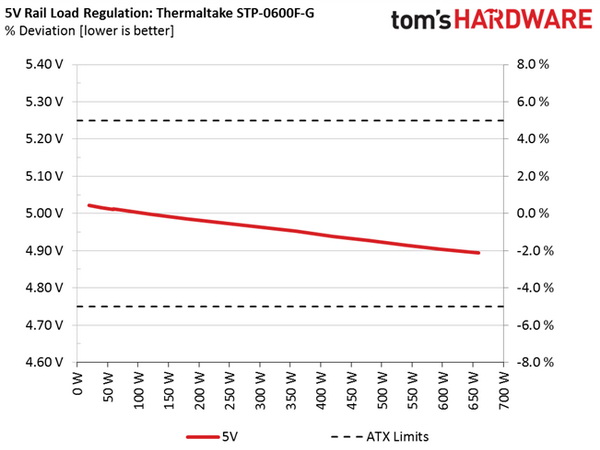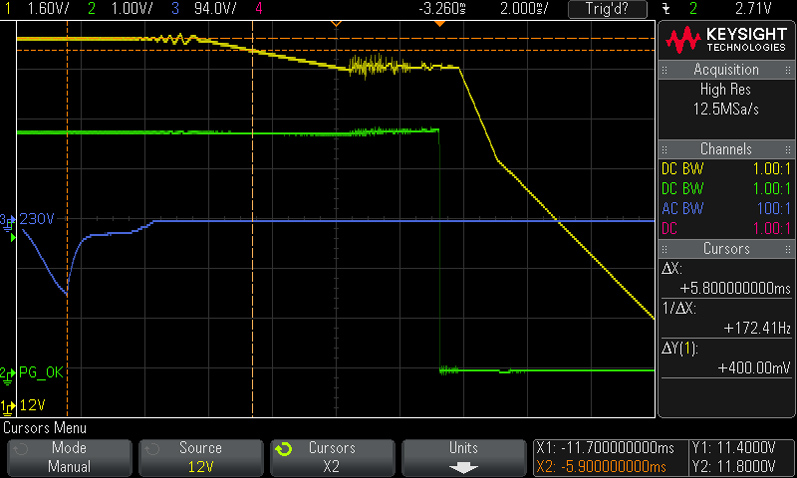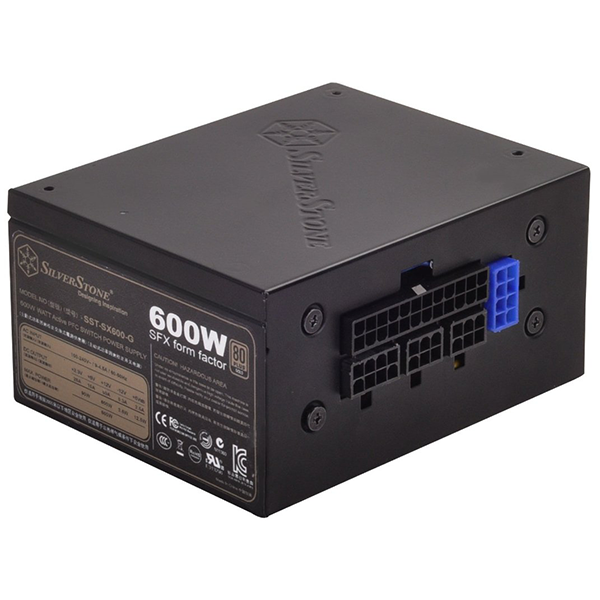Thermaltake Toughpower SFX 600W PSU Review
The highest-end member of Thermaltake's Toughpower SFX Gold line is on our test bench today. It offers Gold efficiency, modular cabling, and a semi-passive fan mode. Thanks to its 600 W capacity, you can easily build a powerful system with it.
Why you can trust Tom's Hardware
Load Regulation, Hold-Up Time And Inrush Current
To learn more about our PSU tests and methodology, please check out How We Test Power Supply Units.
Primary Rails And 5VSB Load Regulation
Load Regulation testing is detailed here.








Hold-Up Time
Our hold-up time tests are described in detail here.







Measured hold-up time is among the lowest we have ever seen. And to make matters worse, the power-good signal drops while the rails are already out of spec. This is unacceptable, especially for a PSU that costs $120. Enhance needs to increase the bulk capacitor's to enable a decent hold-up time.
Inrush Current
For details on our inrush current testing, please click here.


The lack of a bypass relay, which allows the NTC thermistor to cool down quickly, and a lackluster thermistor choice inevitably lead to high inrush currents.
Load Regulation And Efficiency Measurements
Our first set of tests reveals the stability of the voltage rails and the PSU's efficiency. The applied load equals (approximately) 10 to 110 percent of the STP-0600F-G's maximum load in increments of 10 percentage points.
Get Tom's Hardware's best news and in-depth reviews, straight to your inbox.
We conducted two additional tests. During the first, we stressed the two minor rails (5V and 3.3V) with a high load, while the load at +12V was only 0.1 A. This test reveals whether a PSU is Haswell-ready or not. In the second test, we determined the maximum load the +12V rail could handle with minimal load on the minor rails.
| Test # | 12V | 5V | 3.3V | 5VSB | DC/AC (Watts) | Efficiency | Fan Speed | Fan Noise | Temps (In/Out) | PF/AC Volts |
|---|---|---|---|---|---|---|---|---|---|---|
| 1 | 3.160A | 1.995A | 1.984A | 0.991A | 59.74 | 80.63% | 2245 RPM | 34.9 dB(A) | 39.34 °C | 0.963 |
| 12.080V | 5.010V | 3.323V | 5.026V | 74.09 | 44.06 °C | 115.1V | ||||
| 2 | 7.366A | 3.000A | 2.988A | 1.195A | 119.75 | 88.04% | 2300 RPM | 36.5 dB(A) | 40.03 °C | 0.976 |
| 12.065V | 4.998V | 3.312V | 5.009V | 136.02 | 45.04 °C | 115.1V | ||||
| 3 | 11.937A | 3.510A | 3.513A | 1.400A | 179.84 | 89.35% | 2360 RPM | 37.2 dB(A) | 40.58 °C | 0.970 |
| 12.043V | 4.986V | 3.299V | 4.995V | 201.27 | 46.12 °C | 115.1V | ||||
| 4 | 16.519A | 4.022A | 4.009A | 1.604A | 239.78 | 89.78% | 2470 RPM | 38.3 dB(A) | 41.25 °C | 0.981 |
| 12.022V | 4.975V | 3.291V | 4.981V | 267.08 | 47.88 °C | 115.2V | ||||
| 5 | 20.768A | 5.032A | 5.030A | 1.810A | 299.71 | 89.76% | 2660 RPM | 40.8 dB(A) | 41.56 °C | 0.988 |
| 12.002V | 4.963V | 3.278V | 4.968V | 333.89 | 49.48 °C | 115.2V | ||||
| 6 | 25.037A | 6.059A | 6.057A | 2.017A | 359.72 | 89.53% | 2790 RPM | 42.4 dB(A) | 42.54 °C | 0.991 |
| 11.980V | 4.952V | 3.267V | 4.950V | 401.77 | 50.77 °C | 115.2V | ||||
| 7 | 29.319A | 7.085A | 7.095A | 2.225A | 419.59 | 89.11% | 2820 RPM | 43.1 dB(A) | 42.81 °C | 0.993 |
| 11.956V | 4.938V | 3.254V | 4.935V | 470.87 | 51.21 °C | 115.1V | ||||
| 8 | 33.616A | 8.124A | 8.141A | 2.436A | 479.64 | 88.57% | 2950 RPM | 46.9 dB(A) | 43.77 °C | 0.994 |
| 11.936V | 4.927V | 3.242V | 4.918V | 541.54 | 53.29 °C | 115.1V | ||||
| 9 | 38.368A | 8.652A | 8.692A | 2.442A | 539.71 | 87.99% | 3025 RPM | 48.4 dB(A) | 45.42 °C | 0.995 |
| 11.914V | 4.914V | 3.232V | 4.908V | 613.40 | 57.15 °C | 115.2V | ||||
| 10 | 43.083A | 9.177A | 9.220A | 2.550A | 599.52 | 87.31% | 3025 RPM | 48.4 dB(A) | 46.01 °C | 0.996 |
| 11.892V | 4.904V | 3.220V | 4.894V | 686.63 | 60.01 °C | 115.2V | ||||
| 11 | 48.219A | 9.199A | 9.248A | 2.554A | 659.41 | 84.53% | 3025 RPM | 48.4 dB(A) | 46.45 °C | 0.996 |
| 11.867V | 4.894V | 3.211V | 4.886V | 780.11 | 61.12 °C | 115.2V | ||||
| CL1 | 0.100A | 11.016A | 11.004A | 0.000A | 92.29 | 84.11% | 3025 RPM | 48.4 dB(A) | 44.38 °C | 0.988 |
| 12.084V | 4.978V | 3.294V | 5.024V | 109.72 | 55.30 °C | 115.2V | ||||
| CL2 | 49.948A | 1.003A | 1.003A | 1.001A | 606.84 | 87.99% | 3025 RPM | 48.4 dB(A) | 44.61 °C | 0.996 |
| 11.886V | 4.929V | 3.249V | 4.950V | 689.67 | 57.69 °C | 115.2V |
Load regulation is mediocre on all rails; the STP-0600F-G doesn't stand a chance compared to the numbers that Corsair's SF600 achieves. The higher ambient temperature inside of our hot-box doesn't allow Thermaltake's passive mode to engage, and the fan profile is aggressive when it gets this hot. Thankfully, the small fan isn't particularly loud compared to other 80 mm fans, so up to the 40% load test, we record lower than 40 dB(A) results. As for efficiency, the PSU satisfies the 80 PLUS Gold requirements under 20% and 100% loads, and comes close to the corresponding threshold under mid-load. Given very high operating temperatures, we can easily give it a pass.
Take a closer look at the table above and you'll see efficiency drop dramatically under 110% load. Clearly, the STP-0600F-G is hugely stressed by 660 W of load. Aside from low efficiency, it also makes a high-pitched noise and ripple on its rails is way above the limits. Thermaltake claims a 720 W peak load, though that doesn't look to be 100% true. You may be able to apply such a load level, but expect terrible ripple suppression and very low efficiency. So, whether you want to overload it for short periods is your choice. We have to warn you, though, that you'd also be applying huge stress to your other hardware, since high ripple shortens the life of components like electrolytic caps. It also significantly affects the performance of voltage regulation circuits, jeopardizing stability.
Current page: Load Regulation, Hold-Up Time And Inrush Current
Prev Page A Look Inside And Component Analysis Next Page Efficiency, Temperature And Noise
Aris Mpitziopoulos is a contributing editor at Tom's Hardware, covering PSUs.
-
Pixdawg Based on this review, I wouldn't buy the thing for half its listed price. How the devil did it get a Gold rating, anyway?Reply -
Clamyboy74 You would only need 2 pcie cables since these psu are designed for sff builds, with only 1 gpu since you also use a m-itx board.Reply -
turkey3_scratch This power supply is a disaster. It does not have working protection circuitry and should be a 450W unit, not a 600W unit.Reply
This thing sucks.
This unit is a 450W power supply IMO. Basically, Thermaltake probably took their 450W power supply, slapped 600W on it, kept the same amount of PCIe cables, and called it a 600W power supply. This power supply is stupid, I don't know who would buy it. That's just my opinion of course, but safety should be the most important thing of a power supply, and even thought it didn't blow up, if it had 510mv of ripple at 110% load, imagine what it had at 140% load before it shut off? Probably 2000mv of ripple. There goes the GPU. There goes the CPU. There goes everything!
But Thermaltake knows that not a single person who purchases this thing will have done their PSU research, and therefore not a single person buying this thing will probably have a system that demands more than 250-300W. Thermaltake preys on the vulnerabilities of the uneducated, it's a disgrace, it's disgusting.
18596603 said:You would only need 2 pcie cables since these psu are designed for sff builds, with only 1 gpu since you also use a m-itx board.
You wouldn't need a 600W power supply with an SFF build period. It razzes my berries that the mere fruit of the existence of this thing is an example of an unethically engineered product that nobody needs but is designed for those who don't know what they don't need. -
jonnyguru Reply18596603 said:You would only need 2 pcie cables since these psu are designed for sff builds, with only 1 gpu since you also use a m-itx board.
Not until the Corsair SF Series was released while I was sitting behind a desk at Corsair did I realize just how many people use SFX power supplies in full size cases. Absolutely AMAZES me. So.. yeah... -
cats_Paw As much as I give Tomshardware a lot of pain for many of their articles This one is a very solid test.Reply
The PSU is one of the most important parts of the PC (Id say its THE most important), so a good review of a PSU is always welcome.
Well done toms. -
Dark Lord of Tech I commend Thermaltake for releasing into the SFX market , more competition is good for the industry. With very little to choose from , it's still a huge plus to have more SFX units out there on the retail market.Reply -
turkey3_scratch Reply18599544 said:I commend Thermaltake for releasing into the SFX market , more competition is good for the industry. With very little to choose from , it's still a huge plus to have more SFX units out there on the retail market.
Yeah but this is not what I'd call competition... Nobody needs to compete against Thermaltake's product since it stinks. -
nem3s1s GOOD QUALITY as usual on Enhance but seems they need smart enginiers to up level to the designs. wireless etcReply


